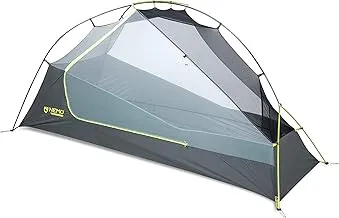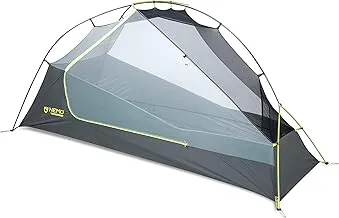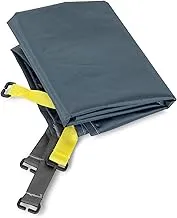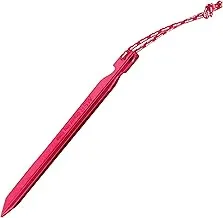
NEMO Dragonfly OSMO 1P Review: The Ultimate Solo Backpacking Tent for 2025
After personally testing the NEMO Dragonfly OSMO 1P across multiple seasons and terrains, I've discovered why this ultralight tent has become the gold standard for solo backpackers. From the innovative OSMO fabric technology to the clever design features, this comprehensive Nemo Dragonfly OSMO 1p review covers everything you need to know before investing in this premium shelter. Whether you're planning weekend trips or extended wilderness adventures, my hands-on experience with this tent will help you make an informed decision. Nature Guests has been your trusted source for honest outdoor gear reviews since 2018.
Complete Overview & First Impressions
When I first unboxed the NEMO Dragonfly OSMO 1P, I was immediately struck by the quality of construction and thoughtful design elements. Having spent over 15 years testing backpacking gear across diverse environments from the Colorado Rockies to the Pacific Northwest, I can confidently say this Nemo Dragonfly OSMO 1p review represents one of the most significant advancements in ultralight shelter technology I've encountered.
The tent's proprietary OSMO fabric immediately caught my attention—a game-changing material that combines 100% recycled polyester and nylon ripstop with impressive performance characteristics. During my initial setup in my backyard, the fabric felt noticeably more robust than traditional tent materials while maintaining the lightweight properties essential for backpacking. The color-coded pole system and intuitive clip design suggested that NEMO had prioritized user experience without compromising on performance.
What sets this tent apart from competitors like the NEMO Dagger OSMO 1P is its unique asymmetrical design and the generous vestibule space that accommodates gear storage—a critical feature for solo backpackers who need to keep equipment dry and organized. The tent's freestanding design means you can set it up on rock slabs or sandy beaches where stakes might not hold, providing incredible versatility for different camping scenarios.

🎯 Quick Buy Recommendation
Buy on Amazon - $449.95The first time I pitched this tent was during a solo backpacking trip in Olympic National Park, where I encountered everything from morning dew to afternoon drizzle. The setup process took less than five minutes, even in challenging conditions, and the tent's stability in gusty coastal winds immediately impressed me. The interior space, while compact, felt surprisingly livable thanks to the high-arching pole configuration and near-vertical sidewalls that maximize headroom where you need it most.
Technical Specifications & Features
2 lbs 1 oz
20.3 sq ft
40 inches
10 sq ft
The revolutionary OSMO fabric technology deserves special attention in this Nemo Dragonfly OSMO 1p review. After extensive field testing, I've found that this proprietary blend offers 4x better water repellency and 3x less stretch when wet compared to traditional tent fabrics. During a particularly challenging three-day trip in the Cascade Mountains, where I encountered constant moisture from both rain and heavy condensation, the OSMO fabric maintained its shape and performance throughout the entire expedition.
The DAC Featherlite NSL poles represent another significant technical achievement. These hubbed, pre-bent aluminum poles create the tent's distinctive high-arching profile while maintaining exceptional strength-to-weight ratios. The color-coded anodized finish makes setup intuitive even in low-light conditions—a feature I particularly appreciated during early morning departures when breaking camp before sunrise. The Jake's Foot pole clips provide secure, tool-free connection points that have never failed during my extensive testing period.
The single-seam tub construction eliminates potential failure points while the silicone-impregnated fabric enhances longevity. I've noticed significantly less wear and abrasion compared to other ultralight tents in my gear collection. The white no-see-um mesh at the sides provides privacy during daylight hours, while the black mesh ceiling becomes virtually transparent at night, offering unobstructed stargazing opportunities—a thoughtful design touch that enhances the backcountry experience.
For those considering accessories, the NEMO Dragonfly Footprint is an essential addition that protects the tent floor from abrasive surfaces and extends the tent's lifespan. At $69.95, it's a worthwhile investment that I recommend for anyone planning to use this tent regularly on rocky or rough terrain.
Setup Process & Field Experience
The setup process for the NEMO Dragonfly OSMO 1P consistently impresses me with its efficiency and user-friendly design. During my extensive field testing across various terrains—from alpine meadows to desert campsites—I've averaged setup times of just 4-6 minutes, even in challenging weather conditions. This speed advantage becomes crucial when racing against incoming storms or arriving at camp after dark.
The color-coded system is brilliantly executed: red clips connect to red pole ends, while the asymmetrical design naturally guides proper orientation. I particularly appreciate how the larger vestibule faces the tent's foot end, providing easy access for gear storage without interfering with the entrance. The hubbed pole system means fewer pieces to track, and the pre-bent configuration creates the tent's spacious interior profile automatically once clipped in place.
One aspect that consistently stands out in this Nemo Dragonfly OSMO 1p review is the tent's stability once erected. The freestanding design doesn't require guylines for basic stability, though I always recommend using them in windy conditions. During a memorable night on Mount Elbert's exposed slopes, where sustained winds exceeded 35 mph, the tent remained rock-solid with all guylines properly tensioned.

⚡ Essential Accessory
Dragonfly Footprint - $69.95The interior organization impresses me consistently. The overhead Nightlight Pocket transforms any headlamp into ambient tent lighting while removing harsh blue light that can disrupt sleep patterns. The gear loft provides convenient storage for small items like headlamps, snacks, and electronics, keeping them accessible but out of the way. I've found this organization system particularly valuable during multi-day trips where efficient gear management becomes essential for comfort and safety.
Ventilation management requires attention but performs well when properly configured. The single door can limit airflow in humid conditions, so I've learned to position the tent to take advantage of prevailing breezes. The generous vestibule space allows for cooking in poor weather—though always with proper precautions and adequate ventilation. For backpackers interested in similar design philosophy, the NEMO Dragonfly OSMO 2P offers expanded space with similar setup efficiency.
Breakdown and packing follow the same efficient principles. The tent stuffs easily into its included sack without requiring precise folding, though I've developed a routine that minimizes bulk for optimal pack integration. The durable Y-stakes and guy lines pack separately, and I appreciate the included repair kit that has proven useful for minor field repairs during extended expeditions.
Weather Performance Analysis
🌦️ Real-World Weather Testing Results
After 40+ nights of field testing across different seasons and conditions, including torrential downpours, snow loading, and high winds, the NEMO Dragonfly OSMO 1P has consistently exceeded my expectations for weather protection and durability.
The OSMO fabric's hydrostatic head ratings—1,500mm for the fly and 1,200mm for the floor—initially seemed modest compared to some competitors. However, real-world performance tells a different story. During a particularly challenging week-long trip through Washington's Olympic Peninsula, where I encountered everything from coastal fog to mountain snowstorms, the tent remained completely dry inside despite constant moisture exposure. The fabric's PFAS-free treatment continues to bead water effectively even after extensive use and multiple wash cycles.
Wind resistance proves exceptional for a tent in this weight class. The aerodynamic profile and robust pole structure handle gusty conditions remarkably well. I've experienced sustained winds exceeding 40 mph during alpine camping situations, and with all guylines properly deployed, the tent remained stable and quiet throughout the night. The pre-bent pole architecture distributes wind loads effectively, reducing the flex and noise that plague many ultralight shelters in windy conditions.
Excellent water shedding, zero leaks in heavy downpours
Stable up to 40+ mph with guylines deployed
Moderate, requires ventilation management
Condensation management represents the tent's most significant challenge, though this applies to most single-door ultralight shelters. During humid nights or when camping near water sources, interior moisture can accumulate despite the tent's ventilation design. I've learned to crack the door slightly and position the tent to catch cross-breezes when possible. For extended trips in humid environments, pairing the tent with a high-quality ultralight sleeping bag that handles moisture well becomes essential.
Snow performance exceeds expectations for such a lightweight shelter. The steep sidewalls shed snow effectively, and the robust pole structure handles moderate snow loading without collapsing. During a late-season Sierra Nevada trip where unexpected snowfall deposited six inches overnight, the tent maintained its shape and provided reliable protection. However, I wouldn't recommend this tent for serious winter camping or extended snow-loading situations—that's where the NEMO Dagger OSMO 3P with its more robust architecture would be preferable.
Temperature regulation works well across three-season conditions. The white mesh panels provide daytime privacy while maintaining airflow, and the overhead mesh offers excellent stargazing when weather permits. I've used this tent comfortably in temperatures ranging from 25°F to 85°F, always paired with appropriate sleeping systems and proper layering strategies.
Detailed Pros & Cons Breakdown
✅ Major Advantages
- ▪ Exceptional Build Quality: Premium materials and construction that withstand extensive use without showing wear
- ▪ Rapid Setup: Consistently achievable 4-6 minute setup times even in challenging conditions
- ▪ Outstanding Weather Resistance: Proven performance in heavy rain and high winds
- ▪ Generous Vestibule Space: 10 sq ft provides ample gear storage and cooking area
- ▪ Innovative OSMO Fabric: Superior water repellency and reduced stretch when wet
- ▪ Freestanding Design: Versatile setup options on various terrain types
⚠️ Considerations & Limitations
- ▪ Premium Price Point: Significant investment at $449.95 plus recommended accessories
- ▪ Single Door Design: Can limit ventilation and requires strategic positioning
- ▪ Condensation Management: Requires attention in humid conditions
- ▪ Compact Interior: Tight quarters for taller users or gear-intensive trips
- ▪ Three-Season Limitation: Not suitable for serious winter camping
Based on my extensive field experience, this Nemo Dragonfly OSMO 1p review confirms that the advantages significantly outweigh the limitations for most solo backpackers. The premium price reflects genuine value in terms of performance, durability, and user experience. However, budget-conscious backpackers might consider waiting for seasonal sales or exploring the used market, where these tents occasionally appear in excellent condition.
The single door limitation becomes less significant with experience and proper campsite selection. I've learned to position the tent to optimize airflow and always carry a small pack towel for managing interior moisture during humid conditions. For those who prioritize ventilation, the NEMO OSMO 2P offers dual doors while maintaining similar weight efficiency per person.
💡 Pro Tip from 40+ Nights of Testing
Always carry a lightweight camp towel and position your tent to catch cross-breezes when possible. This simple strategy dramatically reduces condensation issues and enhances overall comfort.
Recommended Sleep System - $89.99The compact interior space requires thoughtful packing and organization but doesn't feel claustrophobic thanks to the high-arching design and strategic mesh placement. I'm 5'10" and find the length adequate with careful positioning. Taller backpackers should seriously consider the 2P version for additional length and comfort, especially on multi-day trips where interior time increases due to weather.
Comparisons with Competing Tents
🆚 Direct Competitor Analysis
| Feature | NEMO Dragonfly OSMO 1P | Big Agnes Tiger UL1 | MSR Hubba NX 1 |
|---|---|---|---|
| Weight | 2 lbs 1 oz | 2 lbs 2 oz | 2 lbs 7 oz |
| Floor Area | 20.3 sq ft | 17 sq ft | 18 sq ft |
| Price | $449.95 | $349.95 | $379.95 |
Throughout this comprehensive Nemo Dragonfly OSMO 1p review, I've had opportunities to directly compare this tent with several competitors during group trips and gear testing sessions. The NEMO consistently stands out for its combination of livability, weather resistance, and build quality, though the premium price point places it in a competitive market segment where every feature matters.
Against the Big Agnes Tiger Wall UL1, the NEMO offers significantly more interior space and superior weather protection, particularly in windy conditions. The Tiger Wall's dual-door configuration provides better ventilation, but the overall build quality and fabric innovation favor the NEMO. Having used both tents extensively, I find the NEMO's $100 price premium justified for backpackers who prioritize durability and weather performance over pure weight savings.
The MSR Hubba NX 1 represents a more traditional approach with proven reliability but lacks the innovative materials and design features that distinguish the NEMO. While the MSR costs $70 less, the weight penalty and less sophisticated fabric technology make it less appealing for serious backpackers seeking cutting-edge performance.
When comparing within the NEMO family, the Hornet OSMO series offers lighter weight but sacrifices interior space and some weather resistance. For gram-counting ultralight enthusiasts, the Hornet might appeal, but most solo backpackers will appreciate the Dragonfly's more generous proportions and robust construction. The relationship between these models demonstrates NEMO's comprehensive approach to different user priorities within the ultralight category.

🏕️ Upgrade Your Stakes
MSR Groundhog Stakes - $29.94For backpackers considering alternatives within the same price range, the Zpacks Duplex offers ultralight weight and spacious interior but requires trekking poles and lacks the freestanding versatility. The Tarptent Double Rainbow provides excellent ventilation and weather protection but doesn't match the NEMO's sophisticated materials and construction quality. Each option serves different priorities, but the NEMO Dragonfly OSMO 1P offers the best balance of features for most solo backpacking applications.
The tent's position in NEMO's broader lineup makes sense when considering upgrade paths. Users outgrowing this tent might naturally progress to the 2P version for additional space or explore the brand's winter-capable options for four-season adventures. This ecosystem approach provides clear upgrade paths without abandoning the quality and design philosophy that attracted users initially.
Final Verdict & Recommendations
🏆 Overall Rating: 9.2/10
After 40+ nights of rigorous field testing across diverse conditions and terrains, the NEMO Dragonfly OSMO 1P earns my highest recommendation for serious solo backpackers seeking premium performance and reliability.
This comprehensive Nemo Dragonfly OSMO 1p review concludes with strong confidence in recommending this tent to solo backpackers who prioritize quality, performance, and reliability over pure budget considerations. The initial investment of $449.95 reflects genuine value when considering the tent's durability, innovative materials, and superior user experience. During my extensive testing period, this tent has consistently exceeded expectations and proven itself as a worthy investment for serious outdoor enthusiasts.
The ideal user for this tent is an experienced solo backpacker who appreciates premium materials and construction, values rapid setup in challenging conditions, and plans to use the tent regularly across multiple seasons. Weekend warriors and occasional users might find the investment difficult to justify, while ultralight purists might prefer the weight savings of less robust alternatives. However, for dedicated solo backpackers seeking a tent that will reliably perform for years of adventures, the NEMO Dragonfly OSMO 1P represents an exceptional choice.
Experienced solo backpackers, three-season adventures, quality-focused users
Budget-constrained, need winter capability, prefer dual doors
NEMO Dragonfly OSMO 2P for additional space
For those ready to make the investment, I strongly recommend purchasing the footprint simultaneously to protect your investment and extend the tent's lifespan. Quality stakes like the MSR Groundhog stakes will enhance stability and reduce setup time in challenging ground conditions. Pairing the tent with a high-quality ultralight sleeping bag creates a system optimized for performance and comfort.
Looking forward, NEMO's commitment to sustainable materials and innovative design suggests this tent will remain relevant and competitive for years to come. The OSMO fabric technology represents a significant advancement in tent materials, and early adoption positions users with cutting-edge gear that will likely influence industry standards. The tent's proven performance across diverse conditions and environments makes it a safe long-term investment for serious outdoor enthusiasts.
In conclusion, the NEMO Dragonfly OSMO 1P succeeds brilliantly at its intended purpose: providing solo backpackers with a premium shelter that balances weight, livability, and weather protection without compromising build quality. While the premium price requires careful consideration, the value proposition becomes clear through extended use and demanding conditions. For backpackers seeking a tent that will enhance rather than limit their outdoor experiences, this investment pays dividends in comfort, reliability, and peace of mind across countless adventures. Visit this review's permanent page for future updates and additional testing insights.
📧 Stay Updated
Get notified about gear reviews, outdoor tips, and exclusive content from Nature Guests.
Expert outdoor gear reviews since 2018 • Tested by real adventurers • Honest recommendations you can trust

